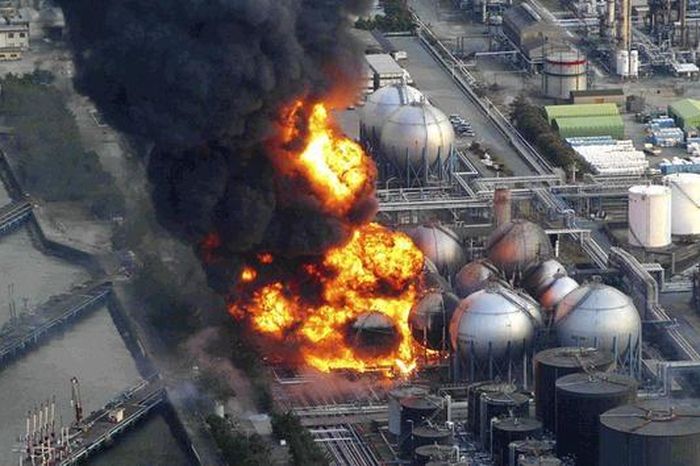Innovative earthquake-resistant design of 3 skyscrapers
Tokyo Skytree - the tallest building in Japan

Japan is located right on the famous Ring of Fire, so earthquakes are frequent. Therefore, the Japanese government took necessary measures to prevent damage by constructing structures specifically designed to withstand earthquakes.
The Tokyo Skytree is a classic example of how Japanese architects handled the constant threat of earthquakes.
Tokyo Skytree has the standard quality that makes a tower earthquake resistant. Historians used exceptionally strong steel pipes at the base of the tower. In particular, there is a column located in the center of the tower, which is not attached to the rest of the tower and vibrates independently of the tower. This column acts as a counterweight in earthquakes to help neutralize the impact of seismic waves.
Capitol Building in Wyoming, USA

This building was built in the 1910s but was not built to the original design of Richard Kletting due to financial difficulties. A later study revealed the building was vulnerable to moderate earthquakes. So, nearly 100 years after its completion, the building was renovated to ensure it could withstand earthquakes. Engineers removed the building's foundation completely, poured in a new layer of concrete carpet and and a total of 280 seismic supports made of laminated rubber layers were installed above the carpet just below the column. original pillar. This renovation allows the building to wobble only slightly during an earthquake.
The renovation of the Capitol building cost $260 million in 2008. The work is also proof that earthquake-resistant buildings can survive even if the original construction fails.
Taipei 101 Building in Taiwan

Taiwan is also an area that experiences many earthquakes. And this is where Taipei 101 is located - the world's tallest building from 2004 to 2009. During its construction, engineers applied a number of solutions to make the building particularly sturdy and able to sway. by earthquakes and hurricanes. The special design makes it able to withstand the strongest earthquakes for 2,500 years.
People have driven 380 stakes 80m deep into the ground to form a stable foundation for the building. In particular, on the 92nd floor of the building, there is a pendulum weighing 660 tons. The motion of the pendulum creates inertia forces that reduce the resonant vibrations generated by wind and earthquakes, limiting the effects of these forces on the building.
You should read it
- In the future, Wood is the only material to build skyscrapers, not concrete or steel
- See Salesforce's $ 1.1 billion building in San Francisco
- These are the 13 weirdest skyscrapers in the world
- Burj Khalifa - the tallest building in the world is about to be usurped, the new world record is about to be established
- The 9-magnitude earthquake cannot affect the server room in Japan, why?
- Top 10 building games on phones
- The top 16 skyscrapers have the most terrible construction funding ever
- 9 things to consider before building a gaming PC
May be interested
- Why do so many skyscrapers in Hong Kong have holes in the middle?
 in hong kong, skyscrapers often have a strange hole called longmen - a dragon's hole makes many people wonder about their reasons for their existence.
in hong kong, skyscrapers often have a strange hole called longmen - a dragon's hole makes many people wonder about their reasons for their existence. - Drug-resistant bacteria greatly affect people living in nursing homes
 a new study shows that 27% of nursing home residents are tested positive for gram-negative bacteria, also known as mdr-gnr (multidrug-resistant tb bacteria).
a new study shows that 27% of nursing home residents are tested positive for gram-negative bacteria, also known as mdr-gnr (multidrug-resistant tb bacteria). - ViewSonic's water-resistant netbook
 vnb100 and vnb101, a colorful fashion model, are simple but wear resistant and water resistant.
vnb100 and vnb101, a colorful fashion model, are simple but wear resistant and water resistant. - Scientists create the world's best heat-resistant material, which can be used for spacecraft
 scientists from the national university of science and technology (nust) in moscow (russia) recently made a ceramic-like material that is more heat-resistant than any other material.
scientists from the national university of science and technology (nust) in moscow (russia) recently made a ceramic-like material that is more heat-resistant than any other material. - How to use Nokia Lumia 920 effectively
 nokia lumia 920 is a product that can change the way traditional phones are used. beautiful camera in low light conditions, monolithic design is resistant and scratch-resistant. some users who are new to windows phone 8 may encounter some difficulties in using nokia lumia 920. there are three secrets
nokia lumia 920 is a product that can change the way traditional phones are used. beautiful camera in low light conditions, monolithic design is resistant and scratch-resistant. some users who are new to windows phone 8 may encounter some difficulties in using nokia lumia 920. there are three secrets - 5 ways to cool the roof in extremely hot and sunny days
 the roof is especially the iron roof that absorbs a lot of heat and radiates heat directly into the house. so, how to resist heat for roofs to achieve the highest efficiency?
the roof is especially the iron roof that absorbs a lot of heat and radiates heat directly into the house. so, how to resist heat for roofs to achieve the highest efficiency? - Devastating earthquake disasters in the past 100 years
 there have been terrible earthquakes around the world that have killed tens of thousands of people, haunting all humanity. let's review the most devastating earthquakes in human history in the past 100 years.
there have been terrible earthquakes around the world that have killed tens of thousands of people, haunting all humanity. let's review the most devastating earthquakes in human history in the past 100 years. - New findings: Cows are resistant to HIV virus
 cows are resistant to hiv because their immune systems can quickly produce antibodies that neutralize viruses.
cows are resistant to hiv because their immune systems can quickly produce antibodies that neutralize viruses. - How did bacteria learn to fight antibiotics?
 the emergence of all drug-resistant viruses has actually made people think of a dark future called antibiotic resistance. so what is antibiotic resistance? why is it so dangerous, try to find out!
the emergence of all drug-resistant viruses has actually made people think of a dark future called antibiotic resistance. so what is antibiotic resistance? why is it so dangerous, try to find out! - Your washing machine could be a breeding ground for antibiotic-resistant bacteria without you even knowing it.
 healthcare workers who wash their uniforms at home may be inadvertently spreading antibiotic-resistant bacteria, increasing the risk of hospital-acquired infections, a new study suggests.
healthcare workers who wash their uniforms at home may be inadvertently spreading antibiotic-resistant bacteria, increasing the risk of hospital-acquired infections, a new study suggests.










 FBI Begins Investigation of a Serious Internal Cybersecurity Incident
FBI Begins Investigation of a Serious Internal Cybersecurity Incident Facebook and Instagram are about to sell green ticks, the price is higher than Twitter
Facebook and Instagram are about to sell green ticks, the price is higher than Twitter How to automatically overclock Nvidia GPU with GeForce Experience Performance Tuning tool
How to automatically overclock Nvidia GPU with GeForce Experience Performance Tuning tool What is the AV1 codec? Used for what purpose?
What is the AV1 codec? Used for what purpose? What is Apple's Neural Engine? How does it work?
What is Apple's Neural Engine? How does it work? How to enable security shortcuts on Xiaomi phones
How to enable security shortcuts on Xiaomi phones